|
A Salute to Uncle Sam
by Bob Brooke
Everyone has heard of Uncle Sam. And
while this name may not roll off the tongues of most people today,
it was very popular from the early 19th century to the mid-20th
century. But who was this character and where did he come from?
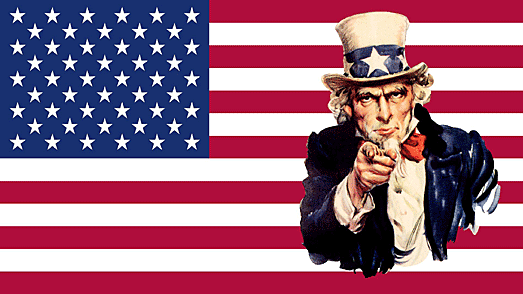
Who Was Uncle Sam?
Supposedly, the term Uncle Sam came from Samuel Wilson, a meat packer
from Troy, New York who supplied barrels of beef and pork to the U.S.
Army during the War of 1812. There was a requirement at the time for
food purveyors to stamp their name and where the rations came from onto
the food they were sending. Wilson labeled his packages "E.A – US."
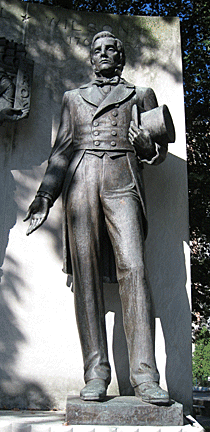 During
a routine check on Sam Wilson’s meat packing plant, government
inspectors, along with a soldier named Pheodorus Bailey, spotted the
stacks of crates marked “U.S.” and wanted to know what it meant. A meat
packer, either with a sense of humor, or not knowing the true meaning of
the letters, informed the officials they must be the initials of his
employer, “Uncle Sam.” During
a routine check on Sam Wilson’s meat packing plant, government
inspectors, along with a soldier named Pheodorus Bailey, spotted the
stacks of crates marked “U.S.” and wanted to know what it meant. A meat
packer, either with a sense of humor, or not knowing the true meaning of
the letters, informed the officials they must be the initials of his
employer, “Uncle Sam.”
The soldiers began referring to the grub as “Uncle Sam’s.” The local
newspaper picked up on the story, and Uncle Sam eventually gained
widespread acceptance as the nickname for the U.S. Government.
Samuel Wilson was born on September 13, 1766 in Massachusetts at a little
place called Menotomy, which has since been renamed Arlington. He became
a patriot very early on. When Sam was 8 years old, he became a drummer
boy. A year later he warned everyone in the village that the Redcoats
were coming by beating on his drum while on duty in Menotomy’s village
green. By the time he had turned 14, Wilson joined the army and saw
active service.
He was 23 in 1789 when he moved to Troy, New York, where he started a
meat packaging company. He became well respected for his fair and honest
ways and his business flourished. A friendly, happy and convivial man,
he was soon affectionately referred to as "Uncle Sam" by the locals.
Samuel Wilson went on to become active in politics after the War of
1812 and led a full and happy life. He died On July 31, 1854 at age 87.
He may have been forgotten in the rest of the country as the original
Uncle Sam but not in Troy, New York In 1931, the town erected a tombstone in
Oakwood Cemetery which reads: “In loving memory of Uncle Sam, the name
originating with Samuel Wilson.”
There are two memorials to Uncle Sam, both of which commemorate the life
of Samuel Wilson—the Uncle Sam Memorial Statue in Arlington,
Massachusetts, his birthplace, and a memorial near his long-term
residence in Riverfront Park, Troy, New York.
In September 1961, the U.S. Congress recognized Samuel Wilson as “the
progenitor of America’s national symbol of Uncle Sam.”, and was buried
next to his wife Betsey Mann in the Oakwood Cemetery in Troy, New York,
the town that calls itself “The Home of Uncle Sam.”
Images of Uncle Sam
By 1820 New England newspapers began including illustrations of Uncle
Sam. These early drawings show him as a clean-shaven man dressed in a
black top hat and tails. The colorful image we know as Uncle Sam today
came about over the years, with additions by various illustrators.
When Andrew Jackson was president, artists gave Uncle Sam red pants. The
long beard sprouted during Abraham Lincoln's tenure, as a sort of homage
to the president.
But it wasn’t until the late 19th century that artists decided to dress
the popular character patriotically. They added white stripes to his red
pants and added stars and stripes to his top hat. His clothes started to
resemble the National Flag, and soon he became a short, plump and
flamboyantly dressed figure.
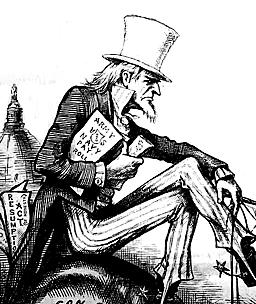 The
noted cartoonist and illustrator, Frank H.T. Bellew was, at one time,
thought to have created the first published form of Uncle Sam, but his
rendition of the character didn’t appear in print until 1852. The
noted cartoonist and illustrator, Frank H.T. Bellew was, at one time,
thought to have created the first published form of Uncle Sam, but his
rendition of the character didn’t appear in print until 1852.
In the late 1860s and 1870s, political cartoonist Thomas Nast, the same
artist who created the image of Santa Claus, began popularizing the
image of Uncle Sam. Nast continued to evolve the image, eventually
giving Sam the white beard and stars-and-stripes suit that everyone
associates with him today. He depicted Uncle Sam as very tall and thin
with sunken cheeks. His drawings were the closest to Samuel Wilson,
although Nast had modeled his version on Abraham Lincoln.
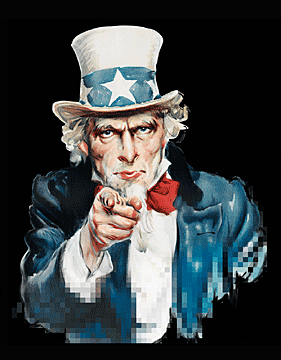 The
most recognizable Uncle Sam and the one that has been most reproduced,
is that of James Montgomery Flagg. He created his version as a self
portrait. This is the famous dour faced, finger-pointing figure that
appeared on World War I posters with the caption "I want you for U.S.
Army." The poster sold 4 million copies during the first world war and
another half million during World War II. The
most recognizable Uncle Sam and the one that has been most reproduced,
is that of James Montgomery Flagg. He created his version as a self
portrait. This is the famous dour faced, finger-pointing figure that
appeared on World War I posters with the caption "I want you for U.S.
Army." The poster sold 4 million copies during the first world war and
another half million during World War II.
There are literally hundreds of Uncle Sam artists. Each one has brought
his own vision of the character into his work and provided countless
pieces of ephemera for today’s collectors, ranging in price from a few
dollars for a postcard to several thousand for an original painting.
Sheet music and greeting cards sell for less than $50 while World War II
posters can go as high as $500.
Bernhardt Wall, another wonderful artist and illustrator, produced Uncle
Sam postcards. Wall had opened his own studio in New York City in 1894
at 22 years of age. As one of the most prolific postcard artists, he
worked with the Ullman Manufacturing Company to produce a fine set of
Independence Day cards depicting a sharply drawn Uncle Sam for the
firm’s Independence Day Series.
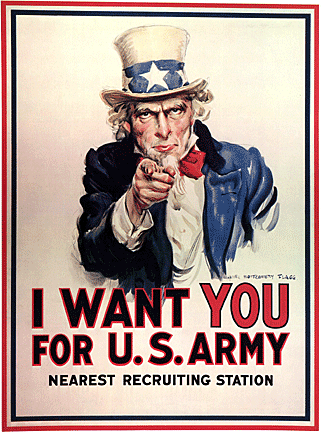 Clare
Victor Dwiggins was another artist who created Uncle Sam cards. He
dropped out of school at 16 and became a hobo before becoming a
cartoonist. Later he worked for. various newspapers and postcard
companies including Raphael Tuck in 1903 on the "Toasts of Today"
series. Clare
Victor Dwiggins was another artist who created Uncle Sam cards. He
dropped out of school at 16 and became a hobo before becoming a
cartoonist. Later he worked for. various newspapers and postcard
companies including Raphael Tuck in 1903 on the "Toasts of Today"
series.
However, Uncle Sam didn’t get a standard appearance until the noted
"recruitment" image of Uncle Sam, created by James Montgomery Flagg,
inspired by a British recruitment poster showing Lord Kitchener in a
similar pose. The immensely popular image first appeared on the cover of
Leslie’s Weekly in July 1916 with the title “What Are You Doing for
Preparedness?” It was this image more than any other that set the
appearance of Uncle Sam—the elderly man with white hair and a goatee,
wearing a white top hat with white stars on a blue band, a blue tail
coat, and red and white striped trousers. In one year, from 1917 to
1918, over four million copies of the image were reproduced.
The U.S. Army used Flagg's image again during World War II, during which
the German intelligence agency Abwehr codenamed the U.S. "Samland." The
term also appeared in the lyrics of the song "The Yankee Doodle Boy",
featured in the musical “Yankee Doodle Dandy” in 1942.
Uncle Sam Collectibles
Manufacturing companies have always found Uncle Sam helped to promote
their wares and thousands of them have used his image to advertise their
products. Early advertising pieces such as trade signs, freestanding
store counter signs, tobacco tins, cigar boxes, match holders, coffee
containers, candy containers, and cookie tins are in great demand by
collectors and can cost hundreds into thousands of dollars.
Of all the Uncle Sam collectibles, the folk art pieces are the most
whimsical. There’s nothing as kitschy as a painted wooden Uncle Sam
holding a mailbox, or a waiter carrying a tray or balancing an ashtray,
or with arms rotating wildly when presented as a whirligig. Since
they’re often one of a king, they tend to be costly, ranging anywhere
from $500 to $1,000 or more.
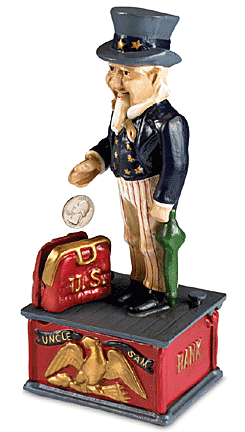 Heavy
cast-iron banks and doorstops have also been fashioned in Uncle Sam's
likeness along with tiny glass, papier-mâché, or metal candy containers,
toothbrush holders, beer steins, and mechanical toys. Since all these
items appeal to cross collectors in multiple categories, they, too, tend
to cost more. Heavy
cast-iron banks and doorstops have also been fashioned in Uncle Sam's
likeness along with tiny glass, papier-mâché, or metal candy containers,
toothbrush holders, beer steins, and mechanical toys. Since all these
items appeal to cross collectors in multiple categories, they, too, tend
to cost more.
Collectors of late 19th- and early 2Oth-century lithography toy drums,
watering cans, and sand pails will find some superb Uncle Sam graphics
available.
Doll collectors have an assortment of Uncle Sam dolls to choose from,
including examples in bisque, composition, celluloid, rubber and even
wax for the early ones along with the more modern plastic versions. The
Vogue Company issued a two-doll set of Uncle Sam and Miss America, each
three inches tall, made of composition with moveable limbs, and
patriotically dressed, selling for around $600 for the pair. However,
there are lots of newer plastic dolls at garage sales and flea markets.
The list of Uncle Sam collectibles goes on and on. Examples of early
pillows, quilts, table or kitchen linens, scarves, and embroidered or
printed linens and silks all come with images of Uncle Sam. Companies
produced most of these pieces during times of great patriotic feeling
like world’s fairs, expositions, early presidential campaigns, and when
the U.S. was at war. Unfortunately, not too many of these items come on
the market, so can be expensive.
<
Back to More Antique Spotlights
Next Article > |
